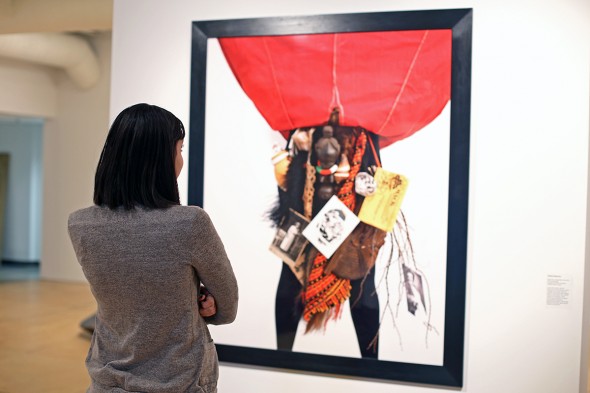‘Ghost Nature’ reminds us of human’s role on Earth

Gallery 400 intern Francesca Banks takes a look at artwork from the “Ghost Nature” exhibit, on display through March 1. Photo: Timothy Nguyen
By Eva Meier
A peculiar, yet fascinating exhibit at Gallery 400 had me contemplating our connection to the Earth in a way that I had not before. We can’t consider ourselves “guests” on Earth anymore. It’s our home, and is here for us to appreciate, cultivate and innovate as time moves forward.
“Ghost Nature,” an exhibit with contributions from UIC students and other artists, reflects the two-way connection Earth has with humankind. The exhibit is on display through March 1 at Gallery 400, located on the first floor of Art and Design Hall, 400 S. Peoria St. Exhibit hours are 10 a.m. to 6 p.m. Tuesday through Friday and noon to 6 p.m. Saturday.
With mediums ranging from video clips to raw vegetables, the artists convey an underrated, yet significant message: People don’t simply take from the Earth anymore; we take, then observe, then modify and enhance.
The artists each took creative and personal license on their interpretations of the different aspects of the Earth.
One such work is Rebecca Mir Grady’s “Long Distance Relationship with the Ocean,” in which she writes the equivalent of a love note to the ocean itself. You can literally feel the relationship Mir Grady has with the sea through her memo — intimate and comforting, reminiscent of another part of her life, and completely unrelated to the cold, hard, urban city where she is now. The piece creatively and personally portrays her relationship with the Earth by presenting a piece of herself in her note to the “deep blue.”
Lounging beside the rest of the exhibits, a lone beetle (yes, one of those disgusting, speedy little critters) surveys the happenings at Gallery 400. But never fear, as gross as the little plumbing-dwelling creatures may be, this one happens to be a sculpted replica. Making me physically tense for a moment was Jenny Kendler’s “Companion for Utopian” piece.
Kendler’s exhibit is self-explanatory by portraying a very literal version of our virtually invisible, yet everyday companions. I found this particular piece to be a bit of an anomaly, as I reluctantly moved closer to the little critter. The beetle symbolized the life on Earth that we don’t particularly notice happening every day, the life that is everywhere.
These pieces are just two in the collection of quirky, but analogous, room full of videos, sculptures and paintings. Conceptually, the content of the exhibit is riveting. The fact that the exhibit moved away from the popular topic of the worldwide eco-friendly movement was a refreshing spin on the human-Earth interaction, especially from young artists.
The exhibit offers a reminder to those who forget that we are part of Earth, too, not just residents for the time being.
Life began on Earth, and though it may not finish here, mankind should always reflect and appreciate the life, beauty and innovation that Earth offers us.
• Eva Meier is a freshman in English. Reach her at emeier2@uic.edu
